Themed collection Editor’s Choice: Making sense of nanosensors and devices

Two-dimensional materials and their prospects in transistor electronics
During the past decade, two-dimensional materials have attracted incredible interest from the electronic device community.
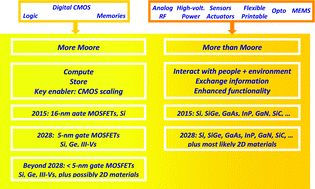
Nanoscale, 2015,7, 8261-8283
https://doi.org/10.1039/C5NR01052G
Ratiometric fluorescence, electrochemiluminescence, and photoelectrochemical chemo/biosensing based on semiconductor quantum dots
Ratiometric fluorescent sensors, which can provide built-in self-calibration for the correction of a variety of analyte-independent factors, have attracted particular attention for analytical sensing and optical imaging with the potential to provide a precise and quantitative analysis.

Nanoscale, 2016,8, 8427-8442
https://doi.org/10.1039/C6NR01912A
Recent developments in 2D layered inorganic nanomaterials for sensing
A comprehensive overview on the recent developments in the application of 2D layered inorganic nanomaterials as sensors is presented. Salient features of 2D materials in different sensing applications viz. gas sensing, electrochemical sensing, SERS and biosensing and photodetection are discussed.
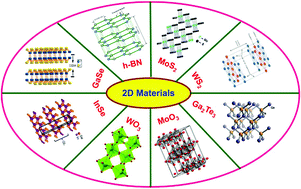
Nanoscale, 2015,7, 13293-13312
https://doi.org/10.1039/C5NR03633J
Wearable, wireless gas sensors using highly stretchable and transparent structures of nanowires and graphene
Wearable, wireless gas sensors based on silver nanowire (AgNW)–graphene hybrid nanostructures provide superb real-time sensing performances and mechanical robustness.
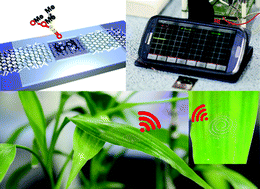
Nanoscale, 2016,8, 10591-10597
https://doi.org/10.1039/C6NR01468B
A SERS-active sensor based on heterogeneous gold nanostar core–silver nanoparticle satellite assemblies for ultrasensitive detection of aflatoxinB1
A surface-enhanced Raman scattering (SERS) sensor based on gold nanostar (Au NS) core–silver nanoparticle (Ag NP) satellites was fabricated for the first time to detect aflatoxinB1 (AFB1).
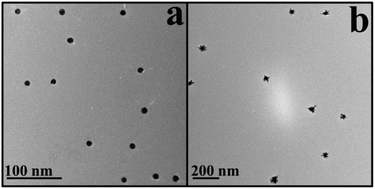
Nanoscale, 2016,8, 1873-1878
https://doi.org/10.1039/C5NR08372A
Boosting the sensitivity of Nd3+-based luminescent nanothermometers
(Gd0.991Nd0.009)2O3 nanorods exhibit one of the highest thermal sensitivity and temperature uncertainty reported so far, 1.75 ± 0.04% K−1 and 0.14 ± 0.05 K, respectively.
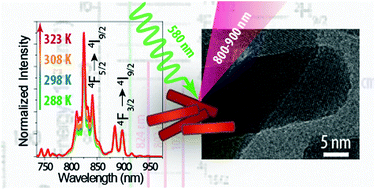
Nanoscale, 2015,7, 17261-17267
https://doi.org/10.1039/C5NR05631D
Improved UV photoresponse of ZnO nanorod arrays by resonant coupling with surface plasmons of Al nanoparticles
An MSM structural photodetector decorated with Al nanoparticles has been fabricated to improve the performance of ZnO NRAs UV detector. Both high photoresponsivity and fast temporal response are also obtained.

Nanoscale, 2015,7, 3396-3403
https://doi.org/10.1039/C4NR07114J
Efficiency enhancement of planar perovskite solar cells by adding zwitterion/LiF double interlayers for electron collection
Electron-collection double interlayers of rhodamine 101 and LiF simultaneously improve open-circuit voltage and fill factor of perovskite solar cells.
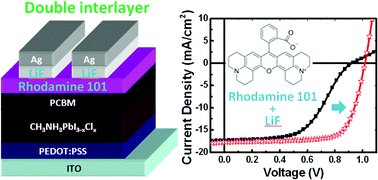
Nanoscale, 2015,7, 896-900
https://doi.org/10.1039/C4NR05975A
Black phosphorus nanoelectromechanical resonators vibrating at very high frequencies
Black phosphorus NEMS resonators of various dimensions and geometries exhibit robust thermomechanical and driven resonances, in both frequency and time-domain.
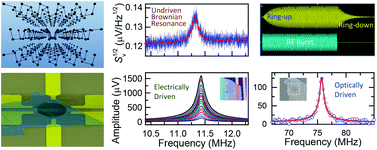
Nanoscale, 2015,7, 877-884
https://doi.org/10.1039/C4NR04829F
Electrically conductive strain sensing polyurethane nanocomposites with synergistic carbon nanotubes and graphene bifillers
Tunable resistance–strain sensing behaviors were achieved by the synergistic graphene and carbon nanotubes in the polyurethane based electrical conductive nanocomposites.
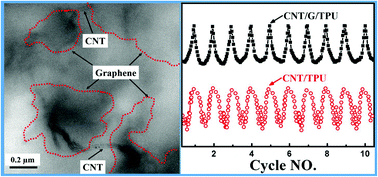
Nanoscale, 2016,8, 12977-12989
https://doi.org/10.1039/C6NR02216B
Selective microwave sensors exploiting the interaction of analytes with trap states in TiO2 nanotube arrays
Vertically oriented metal oxide nanotube arrays integrated with planar microwave resonators can be used to generate selectivity in addition to high label-free sensitivity through the unique interactions of charge carrier traps with surface-adsorbed analytes.
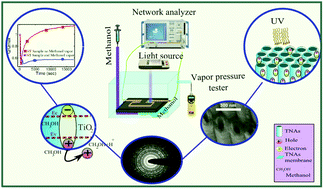
Nanoscale, 2016,8, 7466-7473
https://doi.org/10.1039/C5NR06567D
High-performance perovskite light-emitting diodes via morphological control of perovskite films
SEM images of the MAPbBr3 film and large area green EL from PeLEDs without and with 6 vol% of HBr in the DMF/HBr co-solvent.
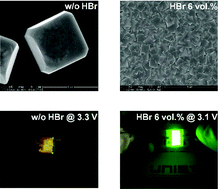
Nanoscale, 2016,8, 7036-7042
https://doi.org/10.1039/C5NR05604G
Effect of relative humidity on crystal growth, device performance and hysteresis in planar heterojunction perovskite solar cells
The effect of relative humidity on the formation of perovskite thin films prepared using the two-step deposition method is reported. Higher relative humidities produce larger, better-connected crystallites, which in turn improves device efficiency and reduces hysteresis.
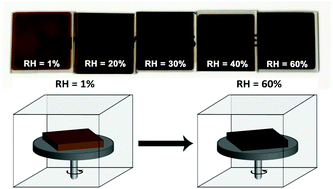
Nanoscale, 2016,8, 6300-6307
https://doi.org/10.1039/C5NR04179A
Graphene-based large area dye-sensitized solar cell modules
We demonstrated the spray coating of graphene ink as a viable method for large-area fabrication of graphene-based dye-sensitized solar cell modules, paving the way to all-printed, transparent and cost-effective large-area photovoltaic devices.
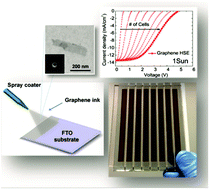
Nanoscale, 2016,8, 5368-5378
https://doi.org/10.1039/C5NR07971C
A gold nanoparticle-based semi-quantitative and quantitative ultrasensitive paper sensor for the detection of twenty mycotoxins
A semi-quantitative and quantitative multi-immunochromatographic (ICA) strip detection assay was developed for the simultaneous detection of twenty types of mycotoxins from five classes, including zearalenones (ZEAs), deoxynivalenols (DONs), T-2 toxins (T-2s), aflatoxins (AFs), and fumonisins (FBs), in cereal food samples.
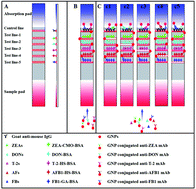
Nanoscale, 2016,8, 5245-5253
https://doi.org/10.1039/C5NR09171C
Laser fabrication of crystalline silicon nanoresonators from an amorphous film for low-loss all-dielectric nanophotonics
Crystalline (low-loss) resonant silicon nanoparticles have been fabricated by femtosecond laser ablation of amorphous (high-loss) silicon thin films using two conceptually different approaches.
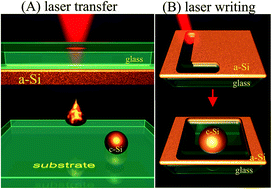
Nanoscale, 2016,8, 5043-5048
https://doi.org/10.1039/C5NR06742A
Label-free and enzyme-free platform for the construction of advanced DNA logic devices based on the assembly of graphene oxide and DNA-templated AgNCs
For the first time a label- and enzyme-free platform for the operation of a series of advanced logic devices is constructed; introducing negative logic, a label- and enzyme-free comparator was also successfully realized.
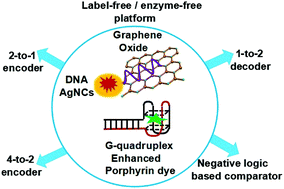
Nanoscale, 2016,8, 3834-3840
https://doi.org/10.1039/C6NR00032K
Inkjet-printed all solid-state electrochromic devices based on NiO/WO3 nanoparticle complementary electrodes
An all solid-state complementary electrochromic device with large optical modulation was assembled by inkjet-printed NiO and WO3 electrodes.
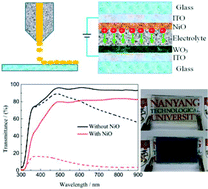
Nanoscale, 2016,8, 348-357
https://doi.org/10.1039/C5NR06995E
3D nanochannel electroporation for high-throughput cell transfection with high uniformity and dosage control
The “3D NEP Chip” with SEM images of critical components and high-throughput cell transfection with a fluorescent dye.
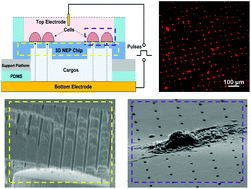
Nanoscale, 2016,8, 243-252
https://doi.org/10.1039/C5NR03187G
Shape-controlled gold nanoparticles supported on MoS2 nanosheets: synergistic effect of thionine and MoS2 and their application for electrochemical label-free immunosensing
A label-free electrochemical immunosensor was developed based on clover-shaped AuNP–Thi–MoS2 nanocomposites.

Nanoscale, 2015,7, 19129-19135
https://doi.org/10.1039/C5NR05614D
Resistive graphene humidity sensors with rapid and direct electrical readout
We demonstrate resistive humidity sensing using a single-layer graphene patch placed on top of a SiO2 layer on a Si wafer.

Nanoscale, 2015,7, 19099-19109
https://doi.org/10.1039/C5NR06038A
Nanoparticle cluster gas sensor: Pt activated SnO2 nanoparticles for NH3 detection with ultrahigh sensitivity
Pt activated SnO2 nanoparticle clusters were synthesized by a simple solvothermal method for use in highly sensitive ammonia gas sensors.
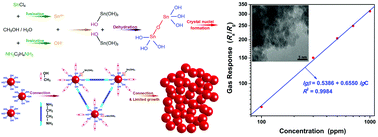
Nanoscale, 2015,7, 14872-14880
https://doi.org/10.1039/C5NR03585F
Combination of carbon dot and polymer dot phosphors for white light-emitting diodes
The white light-emitting diodes with high color rendering index (85–96) and widely variable color temperatures(2805–7786 K) were fabricated from carbon-based nanomaterials with weak reabsorption and no energy transfer crosstalk and showed excellent color stability.

Nanoscale, 2015,7, 12045-12050
https://doi.org/10.1039/C5NR03014E
Dual-emission fluorescent sensor based on AIE organic nanoparticles and Au nanoclusters for the detection of mercury and melamine
A dual-emission ratiometric fluorescent sensor based on AIE organic nanoparticles and Au NCs was prepared by electrostatic interaction. The probe can detect Hg2+ and melamine not only visually but quantitatively.
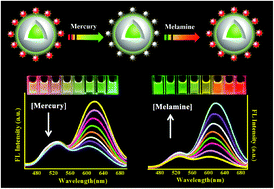
Nanoscale, 2015,7, 8457-8465
https://doi.org/10.1039/C5NR00554J
A highly sensitive and flexible pressure sensor with electrodes and elastomeric interlayer containing silver nanowires
The next-generation application of pressure sensors is gradually being extended to include electronic artificial skin (e-skin), wearable devices, humanoid robotics and smart prosthetics.
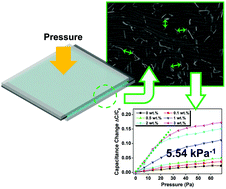
Nanoscale, 2015,7, 2926-2932
https://doi.org/10.1039/C4NR06494A
Flexible 3D porous CuO nanowire arrays for enzymeless glucose sensing: in situ engineered versus ex situ piled
CuO nanowires with vertical array electrode architecture can be applied as a bendable glucose enzymeless sensor, showing outperforming sensitivity over the conventional ex situ drop-cast CuO nanowire/glassy carbon electrode.
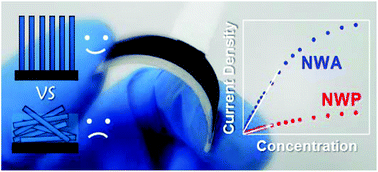
Nanoscale, 2015,7, 559-569
https://doi.org/10.1039/C4NR05620E
About this collection
Professor Xingyu Jiang (Southern University of Science and Technology, China), Nanoscale Associate Editor, introduces his Editor’s Choice collection.
“Sensors are ubiquitous in today’s society. Without sensors, smart phones would not exist. Developing better sensors will be critical for next generation technologies such as augmented reality and wearable electronics. Nanoscale materials and devices comprise the core technology in making sensors faster, smaller and more reliable. This special issue outlines highly cited reports in Nanoscale on the synthesis of nanomaterials and fabrication of devices.”